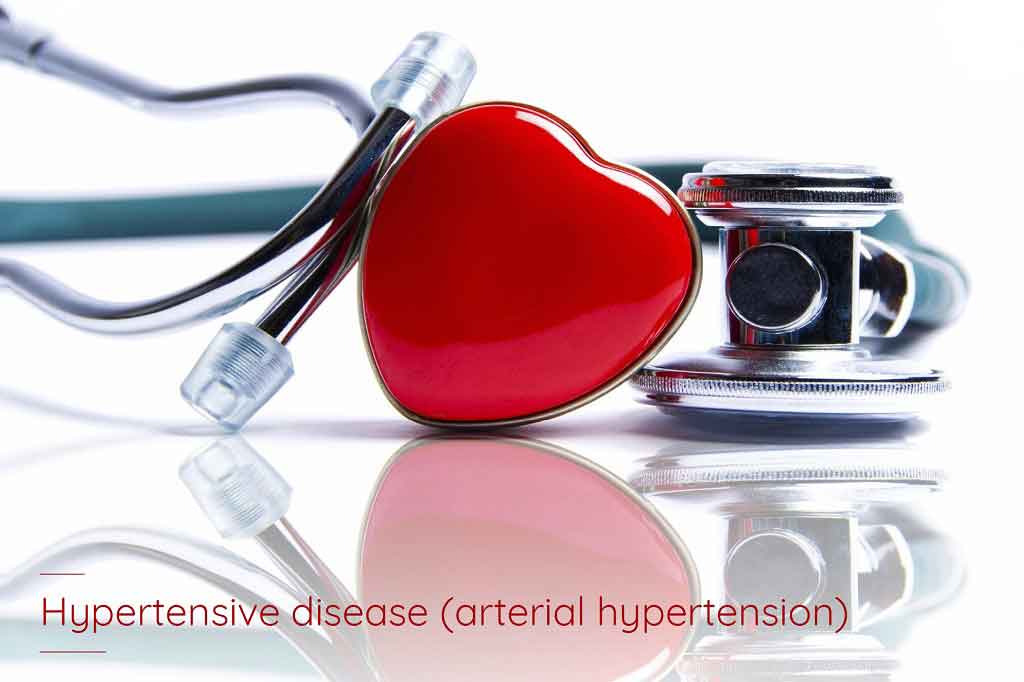Hypertensive disorder
Introduction
 Arterial hypertension, often referred to as the ‘silent killer’ is one of the major causes of cardiovascular disease and mortality. The correct diagnosis and timely treatment of this condition are important factors which lower the risk for sustaining heart, brain or kidney damage. In around 95% of cases, arterial hypertonia is considered a primary condition, since usually, there are no obvious causes to the disease. In a small percentage of cases, the increase in arterial pressure comes as a consequence of specific causes (secondary hypertonia). Physicians must take care to identify these potential causes since they are crucial to choosing the appropriate course of treatment. What is arterial hypertension? Hypertensive disease is characterized by a spike in maximal pressure, which is also called systolic pressure, or the rise of minimal pressure (diastolic) above normal values. Usually it is the systolic pressure that rises more so than the diastolic. It is difficult to establish reliable criteria about what constitutes an elevated arterial pressure value since physiologically, arterial pressure rises gradually with age. This makes defining this disease somewhat arbitrary. Arterial pressure values vary across different populations and individuals suffering from various other conditions.
Arterial hypertension, often referred to as the ‘silent killer’ is one of the major causes of cardiovascular disease and mortality. The correct diagnosis and timely treatment of this condition are important factors which lower the risk for sustaining heart, brain or kidney damage. In around 95% of cases, arterial hypertonia is considered a primary condition, since usually, there are no obvious causes to the disease. In a small percentage of cases, the increase in arterial pressure comes as a consequence of specific causes (secondary hypertonia). Physicians must take care to identify these potential causes since they are crucial to choosing the appropriate course of treatment. What is arterial hypertension? Hypertensive disease is characterized by a spike in maximal pressure, which is also called systolic pressure, or the rise of minimal pressure (diastolic) above normal values. Usually it is the systolic pressure that rises more so than the diastolic. It is difficult to establish reliable criteria about what constitutes an elevated arterial pressure value since physiologically, arterial pressure rises gradually with age. This makes defining this disease somewhat arbitrary. Arterial pressure values vary across different populations and individuals suffering from various other conditions.
Introduction
Hypertensive disease is characterized by a spike in maximal pressure, which is also called systolic pressure, or the rise of minimal pressure (diastolic) above normal values. Usually it is the systolic pressure that rises more so than the diastolic.
Diagnosis
The diagnosis of arterial hypertension is usually made by evaluating the values of arterial pressure, and assessing whether or not they are above what is considered ‘normal’. This criterion defines which individuals face increased risks for heart and blood vessel damage.
How one should measure arterial pressure
Arterial pressure should be measured while the patient is lying down, and after they have rested for several minutes. The patient must feel calm and relaxed. Arterial pressure is measured by using an apparatus called a sphygmomanometer or a blood pressure meter.
Causes
Factors that affect the onset of symptoms include constitutive genetic factors, neurogenic factors, environmental factors. And other factors like age and gender, profession, smoking, and intoxication.
Causes of secondary hypertension
Diseases and conditions which may cause secondary hypertension are hypertension caused by kidney disease, renovascular hypertension, hypertension due to endocrine disease, hemodynamic hypertension, hypertension caused by pregnancy, hypertension due to consumption of contraceptive substances.
Secondary hypertension
Secondary hypertension is a type of hypertension which is caused as a consequence of another condition. Patients suffer from arterial hypertension randomly. Following the appropriate examinations, it is discovered that this type of hypertension is caused as a result of another disease.
Treatment
Simple lifestyle changes can often help reduce high blood pressure (hypertension), although some people may need to take medication as well. Whether medication is recommended depends on your blood pressure reading and your risk of developing problems such as heart attacks or strokes.
Prevention
High blood pressure can often be prevented or reduced by eating healthily, maintaining a healthy weight, taking regular exercise, drinking alcohol in moderation and not smoking.






 Subscribe
Subscribe Ask the doctor
Ask the doctor Rate this article
Rate this article Find products
Find products